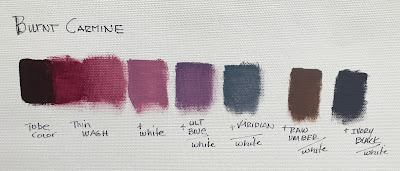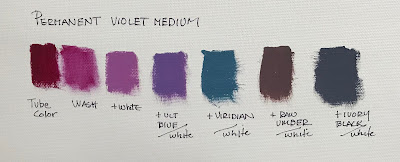I was thinking this morning about the color blue and it’s use in our paintings. It’s the most used color for skies and water, but also can be used for bounced light in shadows and as a color to cool down warmer colors.
Paintings that have a large percentage of their canvas designated to sky or water can run the risk of having the painting look humdrum if there isn’t enough variation of color and may result in loosing the viewer’s attention. Yet, there are many options to add variations to create movement and shifts of color to keep the eye engaged.
For example the sky has what is known as a sky vault, where a lighter value is noticeable at the horizon and darker directly overhead. In addition, the sky closest to the horizon will many times pick up some of the color of the ground in particle reflection. Also, there is a temperature shift that occurs from East to West depending on where the sun resides at the time of observance. This is especially evident in late afternoon sunsets. You can see some examples of these phenomenons below.
There is always opportunity to move color around in a painting’s sky.
Consider interlacing colors other than blue; how about pinks, violets, grays or greens?
Below are a few examples of how artists added freshness into their skies with interplay of color.
detail: Armin Hansen
detail: Derek Penix
detail: Jennifer Moses
detail: Colin Page
CW Mundy
CW Mundy
As for water, there are also many scenarios that allow you to add variety to your blues. A few examples might be – the depth of the water (deeper water versus shallow), still water versus moving water, tides or color reflected from it’s surroundings. The weather can also offer options to help modify the blues in bodies of water, or in the sky for that matter. The idea is to look for possibilities that allow you to manipulate color.
Here are some examples of how artists created an excitement in their water:
detail: J. Lipking
CW Mundy
detail: C. Aspevig
unknown artist
C. Aspevig
A. Patrisi
Now, a look at one way we can play with blues. In this exercise, I concentrated my mixtures with 2 blues: Ultramarine and Prussian blue. You can make a simple grid on a canvas panel or a canvas paper. I used a flat brush, which helps keep my edges sharp.
The Left side is mixtures with Ultramarine and right side with Prussian. Top corners are the color pure with white. My mixtures include random colors chosen from my palette, although you may want to work in some order. Document your the mixes on a separate ledger if you wish to keep track of what colors you used.
It is a great exercise to do… and I encourage you to experiment. If you don’t have Prussian blue, pick other dark blues you typically use and work to create variety. One point I will make is that Ultramarine and Prussian Blues are both intensely dark and transparent, meaning the range of values you can create with these colors is tremendous. Ultramarine leans toward a blue violet and Prussian toward a bluish green. In these mixtures, I have kept blue the dominant color. You can choose any value to work with in this exercise. I kept them a middle value by adding a small amount of white, but you could certainly work lighter by adding more white- just keep each of your mixes as close to the same value, as possible.
As a side note: My Mother, an artist herself, always warned me “NEVER use Prussian blue”. She insisted it was too powerful a color, and would stain every other color and take control of the painting. So for many years I avoided it. However, it is a beautiful blue much different from Ultramarine and I found it worthy of a place on my palette. Look at the artists that embraced Prussian blue: Sargent, Monet, Picasso, Zorn, Van Gogh and Sorolla to name a few (GREAT ones!). I quickly learned to listen to advice, but decide what works best for me and forge forward. The key to every color is to learn it’s potential… which means to play and experiment with your paints.
Remember there are no rules in painting. There are good guidelines to follow, but rules can sometimes stifle our creativity. I offer the above information as my own thoughts, only to foster ideas. It is up to you to create and paint with your own voice.




























